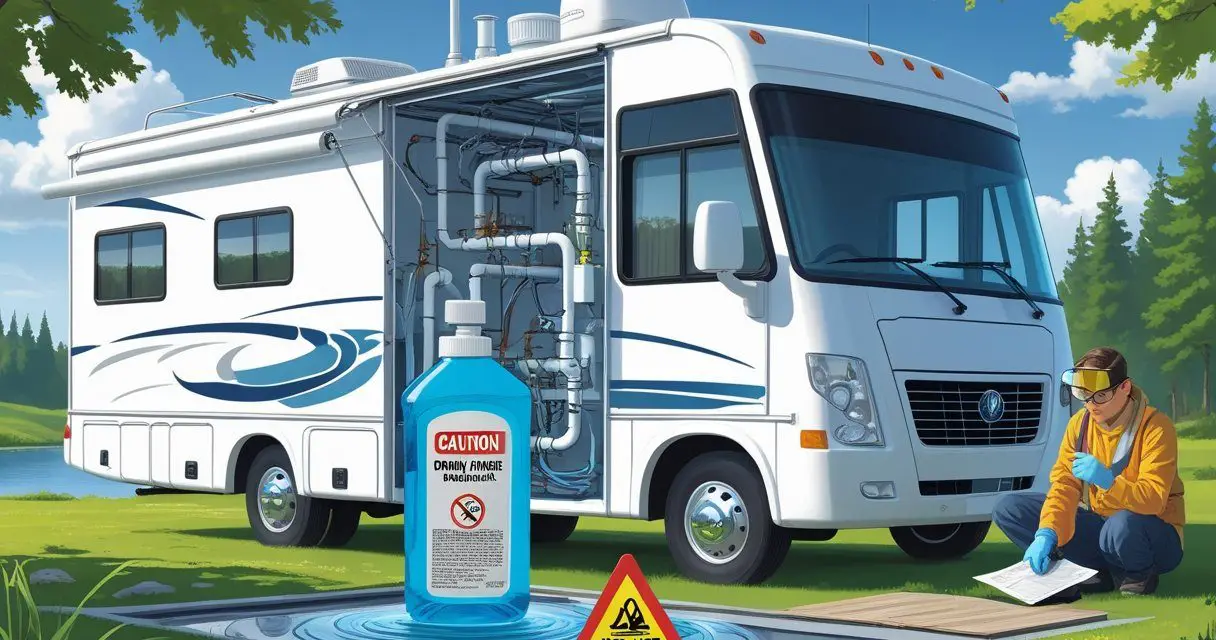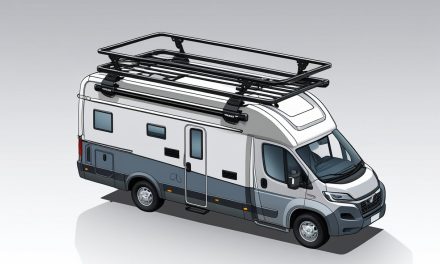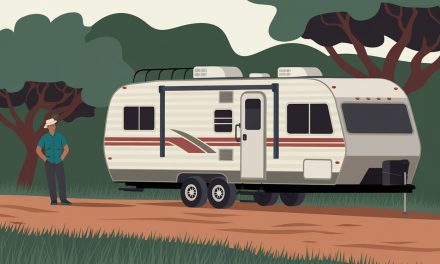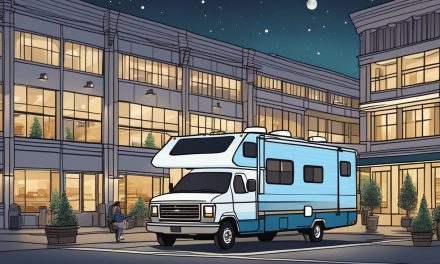Would you like to save this article?
When faced with a clogged RV drain, many campers reach for the same solution they use at home: Drano. However, what works in your house might not be the best choice for your RV’s unique plumbing system.
You should not use Drano in your RV because it can damage rubber seals, PEX pipes, and holding tanks that are common in RV plumbing systems. The harsh chemicals in Drano create heat and corrosive reactions that can eat away at these materials, leading to expensive repairs and potential leaks.
RV plumbing differs significantly from home plumbing, with thinner pipes, rubber components, and waste holding tanks that require gentler treatment. Understanding these differences and knowing safe alternatives can save you from costly damage while keeping your drains flowing smoothly.
Key Takeaways
- Drano can damage RV plumbing components like rubber seals and holding tanks
- Safe alternatives include boiling water, baking soda and vinegar, and enzyme-based cleaners
- Prevention through proper waste disposal and regular maintenance is the best approach
Can Drano Be Used in an RV?
Using Drano in RV plumbing is risky and generally not recommended due to the different materials and systems used in recreational vehicles. RV plumbing systems use lightweight plastic pipes and rubber seals that can be damaged by harsh chemicals.
Drano and RV Plumbing Compatibility
RV plumbing differs greatly from home plumbing systems. Your RV uses thin plastic pipes instead of heavy metal pipes found in houses.
Drano creates heat when it works to dissolve clogs. This heat can damage plastic pipes and rubber seals in your RV’s plumbing system.
The lightweight materials in RV plumbing cannot handle the caustic chemicals in Drano. These chemicals can cause:
- Pipe cracking from heat damage
- Seal deterioration leading to leaks
- Permanent damage requiring costly repairs
Your RV’s plumbing system is also more compact than home plumbing. This means chemicals stay in contact with pipes longer, increasing damage risk.
Manufacturer Warnings and Recommendations
Most RV experts advise against using Drano in RV systems. Even when some manufacturers say it’s okay, many technicians still warn against it.
RV manufacturers design their plumbing for lighter chemicals and gentler cleaning methods. They often recommend:
- Boiling water for minor clogs
- RV-specific drain cleaners made for plastic systems
- Mechanical methods like plungers or snakes
Some manufacturers void warranties if harsh chemicals damage the plumbing system. Check your RV warranty before using any chemical drain cleaner.
Impact on Different RV Drain Types
Kitchen and bathroom sinks have the most risk from Drano. These drains connect directly to your gray water holding tanks through plastic pipes.
RV toilets present special concerns. Your RV toilet connects to the black water holding tank. Drano can damage the toilet’s rubber seals and plastic components.
Shower drains face similar risks as sink drains. The chemicals can eat away at the plastic drain assemblies and pipes.
Holding tanks themselves may handle Drano better than the connecting pipes. However, the chemicals can still damage tank sensors and outlet valves.
Potential Risks and Concerns
Using Drano in your RV can cause serious damage to multiple parts of your plumbing system. The harsh chemicals can destroy rubber components, damage tanks, and create problems at dump stations.
Effects on Rubber Seals and Dump Valves
Drano contains caustic chemicals that eat away at rubber materials in your RV’s plumbing system. Your RV has rubber seals throughout the water lines, connections, and fittings.
These seals keep water flowing in the right direction and prevent leaks. When Drano touches these rubber parts, it can cause them to crack or break down completely.
Your dump valves are especially at risk. These valves control when waste leaves your holding tanks. They contain rubber seals that help them close tightly.
Drano can make these seals wear out much faster than normal. This leads to valves that won’t close properly or leak waste.
Replacing damaged rubber seals and dump valves costs hundreds of dollars. The repairs often require taking apart large sections of your RV’s plumbing system.
Possible Damage to Holding Tanks
Your RV’s holding tanks are made from different materials than home plumbing pipes. Most RV tanks use plastic or fiberglass construction.
Drano creates heat when it works to break down clogs. This heat can warp or crack plastic holding tanks. The chemicals can also eat through tank walls over time.
Black tanks face extra risk because Drano kills the good bacteria that break down waste. Without these bacteria, your tank won’t work properly and odors will get worse.
Gray tanks can also suffer damage from the harsh chemicals. The tank walls may develop weak spots that eventually crack and leak.
Tank sensors that tell you when tanks are full can stop working after contact with Drano. The chemicals coat the sensors and give false readings.
Interactions with Septic Systems
Most RV dump stations connect to septic systems that rely on bacteria to break down waste. Drano kills these helpful bacteria when you empty your tanks.
Dump stations often have rules against emptying tanks that contain harsh chemicals. You could face fines or be banned from using certain facilities.
Private campgrounds with septic systems are especially strict about chemical dumping. They need to protect their expensive septic equipment from damage.
The chemicals in Drano can upset the balance in septic tanks for weeks. This affects other RVers who use the same dump station after you.
Some dump stations test for chemicals and will refuse service if they find them in your tanks.
Safer Alternatives to Drano for RVs
RV owners can protect their plumbing systems by using gentle enzyme-based cleaners, mechanical removal methods, and proper maintenance habits. These approaches work effectively without risking damage to plastic pipes and rubber seals.
Enzyme-Based Drain Openers
Enzyme-based drain cleaners break down organic matter naturally without harsh chemicals. These products use bacteria and enzymes to eat away at hair, grease, and food particles.
Benefits for RV plumbing:
- Safe for plastic pipes and rubber seals
- Won’t create heat that damages components
- Environmentally friendly formula
Popular enzyme cleaners include Bio-Clean and Green Gobbler. Pour the recommended amount down your drain and let it work overnight.
The enzymes need time to break down the clog. You can use these cleaners in RV toilets, sinks, and showers.
They work slower than chemical cleaners but won’t harm your system. Many RV owners use enzyme cleaners monthly as prevention.
Manual Unclogging Methods
Physical removal methods clear clogs without chemicals. These tools work immediately and cost less than professional repairs.
Effective manual methods:
- Drain snakes: Flexible cables that grab and pull out blockages
- Plungers: Create pressure to push clogs through pipes
- Boiling water: Dissolves grease and soap buildup
Start with boiling water for minor clogs. Pour it slowly down the drain in two or three stages.
For stubborn blockages, use a small drain snake designed for RV pipes. A toilet plunger works well for RV toilets.
Make sure you have a good seal around the drain. Push and pull firmly several times to break up the clog.
Routine Maintenance Practices
Regular maintenance prevents most drain problems before they start. Simple daily habits keep your RV plumbing flowing smoothly.
Daily prevention steps:
- Use drain strainers to catch hair and food.
- Avoid pouring grease down drains.
Run hot water after each use. Keep soap and toothpaste residue minimal.
Clean your drains weekly with hot water and dish soap. This removes buildup before it becomes a problem.
Check and clean drain strainers every few days.
For RV toilets, use plenty of water with each flush. Add RV-safe toilet paper that breaks down quickly.
Empty black tanks when they reach two-thirds full to prevent backups.





